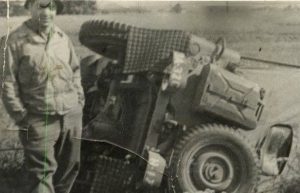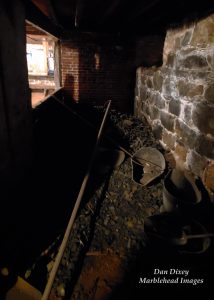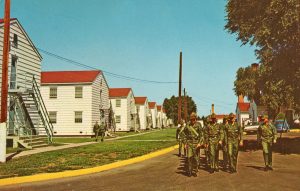The old octopus
Back in the day, our cape cod home on the south side of Kenosha, was heated by a coal furnace. My dad, ever frugal, was one of the last holdouts in the area to convert to oil or natural gas heating. (When the time came, he went with natural gas)
In addition to providing heat, the old coal furnace was quite an entertainment system. It created some lively debate between mom and dad, regarding the necessity to convert to a cleaner, hassle-free fuel. It also generated a test of wills between me and my older brother regarding furnace tending chores. And when fully stoked up the furnace creaked, groaned, banged and whiffed as the flames roared and the sheet metal expanded and contracted with the heat. It was a formidable entity.
When the coal truck came, as it did three or four times during the winter, that was an exciting time also. The metal coal bin door to the basement bin would be opened and a metal chute from the truck would slide through. The coal would be released into the coal bin amidst much banging, roaring and rumbling. Coal dust would be everywhere, and when done the silence seemed deafening.
My dad was very much like the father in “A Christmas Story”. He could change a flat tire quicker than an Indy car team, and he could change an electrical fuse so fast you hardly knew the lights went out. But his real area of mastery was the coal furnace. He could hear a furnace clinker clanking, even with the TV blasting or the radio blaring.
The only way to regulate the heat in the furnace was by adding coal, or adjusting the dampers in the flues which exited the furnace. The temperature in the house was either very warm, or very cool. If anyone messed with the dampers, Dad would quiz everyone in the household, like a prosecuting attorney grilling a murder suspect.
The burnt-out clinkers had to be removed once or twice a week. Our driveway at the time was half dirt, so Dad had us fill the tire ruts with the clinkers. He would then drive over them with the car, forcing them into the ground. After years of forcing clinkers into that driveway, you could have probably parked a Sherman tank on it.
The coal bin was no man’s land for any living thing. Once you entered, you left wearing a layer of coal dust. When we finally converted to natural gas, the nasty coal bin, along with the beastly coal furnace had to be removed. Taking them down and cleaning up after, resembled a federal hazmat operation. And for years after, the area still had black coal dust impregnated into the floor, walls and ceiling joists.
I think what finally triggered my dad into converting was the fact that our chimney was the only one in the neighborhood spewing out the telltale black smoke. “Oh, those darn Campolo’s and their coal furnace!”
A pleasant memory from our coal furnace days was Mom putting orange peels on the furnace vents. The high heat dispersed the orange essence throughout the house. You couldn’t do that with natural gas or oil, because the temperature exiting the vents was lower, and wouldn’t do the job. I miss that nice smell to this day.
My days tending the coal furnace at home, served me well in later life. While serving in the U.S. Air Force at Lowry Air Force Base outside of Denver, Colorado, I was able to put that experience to good use. All of the barracks at the time were built around WWII, and each one was heated by a coal furnace. Two furnace tenders were assigned to each barracks, and since I had experience, I was assigned as one. Being a furnace tender meant I didn’t have to pull KP, or report for early morning physical training. And since I knew my trade well, we stoked up the furnace so as to keep the barracks warm for about five hours. That left us enough time to stroll down Colfax Avenue, hitting all the 3.2 bars along the way, getting back just in time to stoke the furnace before evening muster.
Nothing like an old coal furnace to keep you nice and toasty. 🙂
You are welcome to share Joe’s blogs on Facebook or any other media, in there entirety with citation acknowledging Joe as the author. Copyright protected, all rights reserved © Joe Campolo Jr.




small coal furnace with fan and vent ducts
Joe, was just down looking at a octopus in the basement of our ND time traveler, we acquired the Bungalow years ago and never have touched this vintage piece , did enjoy reading your rendition of home and coal heating remembrances ,the thoughts have entered my mind if this antique could talk how it may sound as you described, I was trying to figure out how to repourpous its existence, maybe a host of flicker flame bulbs and I’ll make a basement lamp out of it..lol.. thanks again Ed from the Sonora desert..
Thanks for sharing Ed. In my youth I took on the task of tearing out an old oil furnace in the basement of a home I owned. What a mess, and as the basement was pretty cruddy, wasn’t much good for anything but storage,so maybe a lamp would have been a better idea.
As a kid in the morning I would turn a mechanism on the baseboard that reached down to the coal furnace. I called it stoking. Maybe that is the wrong turn. It was to shake up the coal to get the heat going for the day. I would like to see a picture of that mechanism. It was round with something to turn. I also would like to know the name of it and what it actually performed.
thank you
Yes, I think that was the shaker handle John. I had not heard of one that went all the way from the baseboard down to the furnace before. It did exactly what you said; shook up the coal to get them burning hotter.
I wonder how I could get picture this mechanism. It was about 3 inches in diameter and looked like a product that was especially made with for it’s purpose
I’m not able to help you with that John
Growing up we had big furnace like that in the basement heated a double Block House and we had a bucket a day for the hot water you just don’t get heat like that today no more